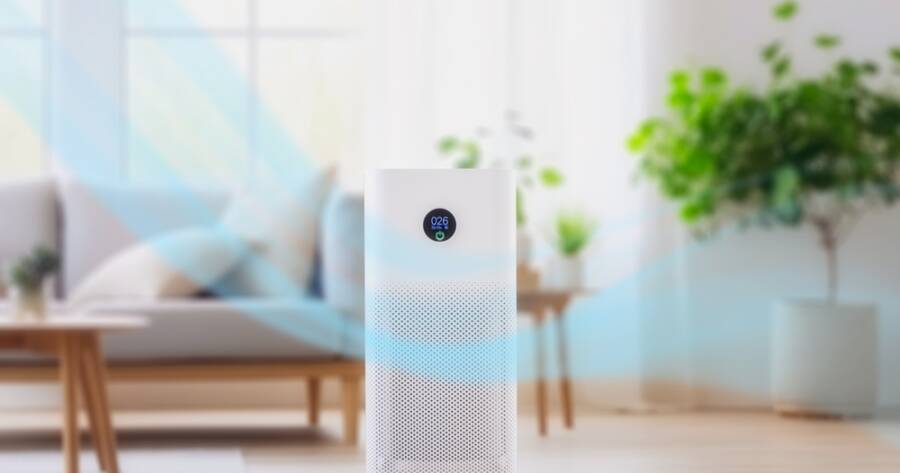Choosing an air purifier can feel overwhelming with so many models and features available. Yet, finding the right one for your home’s size and layout makes all the difference in performance. Air purifiers vary in capacity, filtration quality, and coverage, and using the wrong type for your space means you won’t get the clean air you expect. By understanding how purifier devices work and what specifications to look for, you can make a confident, practical choice that truly improves your indoor air quality.
Step 1: Understand How Air Purifiers Work
All air purifiers follow the same basic principle: they pull air through a filter or cleaning system that traps particles such as dust, pollen, smoke, and pet dander before releasing the air back into the room. Some also reduce odors and airborne bacteria.
The most common and effective systems use HEPA filters (High Efficiency Particulate Air), which capture very fine particles from the air. Other purifiers include activated carbon filters for removing odors and chemical vapors, while some advanced models combine multiple filtration layers for more complete cleaning. Understanding what kind of contaminants you want to remove—whether it’s allergens, smoke, or everyday dust—will help you decide which filter type matters most in your situation.
Step 2: Match Purifier Capacity to Room Size
One of the most important factors in choosing an air purifier is coverage area, usually listed in square feet. Manufacturers rate their devices based on how large a room the purifier can clean efficiently. Choosing a unit that’s too small means the air will cycle too slowly, leaving pollutants behind.
To get the right size, measure your room’s length and width, then multiply them to get the square footage. For open-plan homes or spaces with high ceilings, look for models that can handle slightly larger areas than your calculation. It’s generally better to go a bit above your room size than below, since that ensures consistent airflow and better purification.
Step 3: Consider Your Home’s Layout and Airflow
Your home’s layout influences how effectively an air purifier works. In an open floor plan, air moves more freely, so one larger purifier can often handle several connected spaces. In contrast, homes with multiple closed-off rooms or hallways may need separate units for each area.
Place the purifier where air can circulate easily—away from walls, corners, or furniture that blocks airflow. In multi-room homes, it’s best to position the purifier in the area where you spend the most time, such as a bedroom or living room. Some homeowners also choose to run smaller purifiers in bedrooms and a larger one in central living areas to maintain consistent air quality throughout the home.
Step 4: Check the Clean Air Delivery Rate (CADR)
The Clean Air Delivery Rate (CADR) measures how quickly a purifier removes specific pollutants like dust, pollen, and smoke from the air. A higher CADR means faster and more efficient filtration. While the numbers can vary between manufacturers, they generally give you a good sense of how powerful the purifier is for its size.
As a general guideline, match the CADR number to two-thirds of your room’s area. For example, a room measuring 150 square feet should have a purifier with a CADR of around 100 or higher. This isn’t a hard rule, but it’s a useful benchmark for ensuring the purifier will clean the space thoroughly and consistently.
Step 5: Look for Energy Efficiency and Noise Control
Air purifiers often run for many hours a day, so energy efficiency matters. Models with the ENERGY STAR label meet strict U.S. Environmental Protection Agency standards for energy use, helping you reduce electricity costs over time.
Noise level is another factor that affects comfort. If you plan to run the purifier in a bedroom or office, check the decibel rating. Many modern purifiers include “sleep” or “quiet” modes that reduce fan speed while maintaining adequate filtration, allowing for cleaner air without disturbance.
Step 6: Maintenance and Filter Replacement
Even the best purifier won’t perform well if its filters are neglected. Most HEPA and carbon filters need to be replaced every six to twelve months, depending on usage and air quality. Units with indicator lights can remind you when it’s time for a change. Washable pre-filters can extend the life of main filters by trapping larger debris like pet hair or lint before it reaches the core system.
When comparing models, consider how easy it is to access and replace filters. A user-friendly design saves time and helps you keep the purifier running at full efficiency.
Step 7: Match Features to Your Lifestyle
Modern purifiers come with optional features such as air quality sensors, automatic fan adjustments, and app-based controls. While not essential, these features can make it easier to maintain a consistent environment. For example, smart sensors automatically adjust speed when they detect higher particle levels, ensuring the air stays clean without manual changes.
If you have pets, allergies, or live in an area with frequent wildfire smoke, consider a purifier with stronger filtration and automatic sensing features. If your needs are simple, a basic HEPA model can still provide excellent results without unnecessary complexity.
Clean Air That Fits Your Space
Selecting the right air purifier isn’t about buying the most expensive model—it’s about finding one that fits your home’s size, layout, and lifestyle. By understanding how purifiers work, checking room coverage, and choosing the right placement, you’ll get the most out of your investment.
A properly matched purifier will quietly and efficiently improve your indoor air, helping you breathe easier every day. With the right choice, your air quality—and your comfort—will both improve noticeably.

